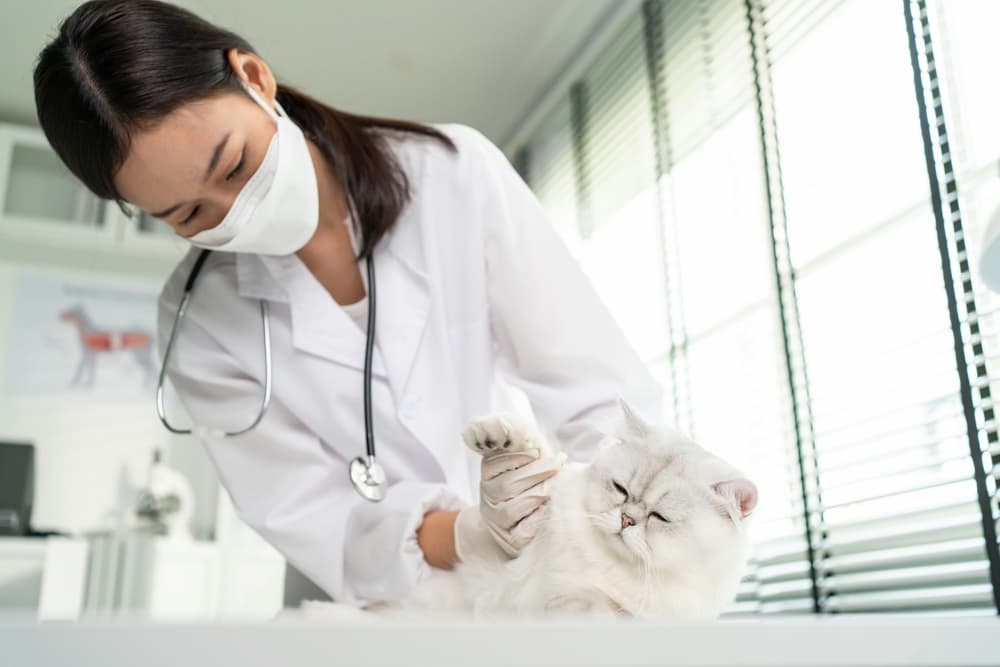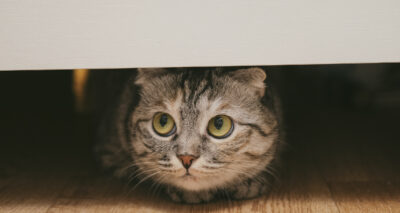Why Do Cats Eat Plastic?

Cat behaviorist Ingrid Johnson has a cat who used to love chewing on the clear plastic shower curtain in her bathroom.
“My one cat would sit on the side of the bathtub and turn her head to the side and crunch, crunch like she was hole punching the shower curtain with her teeth,” says Johnson of Fundamentally Feline, a cat behavior consultation company. “She didn’t even rip it—there are just little holes. For her, it was a sensation thing.”
It might seem strange for a cat to like chomping on plastic, but Johnson says this behavior is surprisingly common. When cats chew on or lick plastic, she says it’s often harmless. But if your cat eats plastic, you have a reason to be concerned.
But what is it about plastic that attracts cats? And is it dangerous for cats to clamp their canines on this stuff?
Why Do Cats Eat Plastic?

Here are a few potential reasons why your cat may be eating, chewing, or licking plastic.
It reminds them of hunting prey
Johnson says cats are mainly drawn to plastic because it appeals to their hunting instincts.
“They like the texture, they like the crunch,” Johnson says. “I think the sensation and the tactile feel on the mouth mimics some of what they’re lacking in the inability to kill prey. You know, like crunching through small bones, flesh, and feathers.”
For this reason, she says cats often seek out plastic with crunch appeal: crinkly plastic bags, cat kibble packaging, and even glossy photos.
Dr. Stephanie Sheen, a veterinarian at Fuzzy Pet Health, says cats may also be interested in plastic cords because they look like mouse tails. Or they might like plastic bags because of the way they move with the wind, resembling prey.
They’re curious—or just plain bored
But there are many other reasons why cats chew, play with, or eat plastic, says Dr. Sheen. Cats of any age might turn to plastic out of curiosity or boredom.
“When a cat does not receive enough mental stimulation through toy play, access to the outdoors, or other environmental enrichment, they can search for ways to interact with their environment to keep themselves entertained,” says Dr. Sheen. “If it continues habitually, chewing plastic can become a compulsive behavior and self-rewarding, a condition called pica.”
They mistake it for food…maybe
Another hypothesis as to why plastic entices cats is because of what it’s made of. Some shopping bags and other plastic products contain animal-derived ingredients, which might make them smell like food, says Johnson.
“This is all speculation,” she says, “but one of the theories is…that cats can still smell and taste some degree of the animal fat or protein in the product, so they’re actually attracted to it for both taste and scent.”
Your cat is a particular breed
Dr. Sheen says some cat breeds might be more predisposed to eating things they shouldn’t, including plastic.
“Oriental breeds, such as Burmese and Siamese cats, are among those, suggesting some genetic component to the behavior,” she says. “However, these breeds tend to prefer cloth items, such as wool, with plastic being less commonly ingested.”
A medical issue may be to blame
According to Dr. Sheen, some medical issues might also make cats more interested in plastic.
“Certain medical conditions that significantly increase appetite, such as diabetes and thyroid disease, can cause cats to eat non-food items like plastic,” she says. “Chronic intestinal disorders that interfere with the absorption of nutrients from the digestive tract, such as inflammatory bowel disease or intestinal parasites, may also increase the likelihood of a cat ingesting plastic. Some cats with dental problems may chew plastic—as well as curious kittens, especially if teething.”
Dangers of Cats Eating Plastic

So your cat likes to bite plastic. Is this behavior harmless? Or dangerous? It depends, says Johnson.
“If you know that your cat does not eat plastic and they just chew on it, and they have a history of being trusted, then I’ve allowed it,” she says. “But I’ve allowed it to happen based on the item. The grocery bags are too risky for me. Larger things like chewing on a bag of pet food or the shower curtain don’t bother me.”
But if a cat does eat plastic—either intentionally or accidentally—it can be a problem, says Johnson. She says shopping bags are one of the most dangerous types of plastic, because they can easily shred and end up down your cat’s throat.
“Usually, it makes its way into the stomach,” says Johnson. “The problem becomes when it gets stuck in the stomach or the intestine, and then they cannot eat and pass stool because they have a foreign body in their GI tract that is affecting digestion and the ability for things to move through.”
Dr. Sheen says it’s also dangerous for cats to ingest pieces of hard plastic with sharp edges, which can puncture the soft tissues of your cat’s stomach or intestines. In some cases, this can lead to a severe infection in the abdomen called septic peritonitis.
“Swallowing plastic, especially if it has sharp edges, can cause punctures or blockages in the stomach or intestinal tract, which can require surgery,” says Dr. Sheen. “Even if a piece of small plastic is able to be eliminated, it can cause quite a bit of irritation as it passes, resulting in diarrhea or bloody stools.”
Besides gastrointestinal issues and infections, plastic ingestion could harm your cat’s health through chemical toxicity. Plastic is manufactured with all kinds of harmful chemicals—including endocrine disruptors like BPA—and these substances are known to cause health issues in humans and animals. According to a study conducted by the Environmental Working Group (EWG), dogs and cats contain high levels of chemicals found in plastics, food packaging, and other products. While the health risks of these chemicals have largely not been studied for our pets, we cannot assume they are completely harmless.
But it’s not just ingesting plastic that can harm your cat. According to Dr. Sheen, rigid plastic can damage cats’ teeth or gums; plugged in electric cords can cause severe mouth burns or lung injuries through electrocution; and plastic bags can suffocate your cat if they crawl entirely into them.
What to Do If Your Cat Eats Plastic

If you notice your cat eating plastic, it’s best to take him or her to a veterinary clinic for an in-person appointment, or to get advice through a veterinary telemedicine service, says Dr. Sheen.
“It’s helpful to know the type and size of the piece that has been eaten and the approximate time it was ingested,” she says.
In many cases, you won’t see your cat eating plastic, but you might see signs that plastic ingestion has occurred. These include:
- Vomiting
- Diarrhea
- Nausea
- Reduced appetite
- Low energy
Johnson says you might also find some bits of plastic in your cat’s stool. “That would be a red flag that there might be more in there,” she says.
After seeking medical advice and care for your cat, you should talk to your veterinarian or a cat behaviorist to learn how to protect your cat from plastic in the future.
How to Prevent Cats from Eating Plastic

Johnson says an easy way to get your cat to stop eating plastic is to provide dry kibble, especially dental kibble that requires your cat to crunch.
“If cats don’t have anything to crunch, they are going to find it,” Johnson says. “So I think it’s important for cats to have some degree of dry food to mimic the feathers, flesh, and bone of what they would be crunching through in the wild. That’s why I actually personally like dental kibble or any kind of oral care type diets that are big kibbles designed to make them crunch and help mimic that sensation and satiate that need.”
Keep in mind that some dental diseases or a recent dental procedure may prevent your cat from being able to chew hard food. If this is the case, always follow your veterinarian’s recommendations.
Johnson also suggests giving cats silver vine sticks, which creates a euphoric effect similar to catnip, but also allows them to chew and crunch.
“That’s a very appropriate and great option for cats that might be otherwise chewing on something inappropriate to give them a good outlet,” says Johnson.
While rawhides can be dangerous for your cat to chew on, especially if they swallow large pieces, you may try products like no-hide chews, some of which are made specifically for felines.
Dr. Sheen says it’s also essential to ensure that your cat doesn’t have access to plastic that could harm their health if they are inclined to chew or eat it.
“You should keep plastic bags in cupboards and place gates or wraps around cords they have shown interest in,” she says. “Promptly throw away any used plastic cutlery or plastic bottles and bottle caps. If removal or access restriction is not possible, products such as bitter apple spray (which can be found at your local pet store) sprayed on the items can be a deterrent but are not 100 percent effective.” While bitter apple spray may be an option for many plastics, it should not be sprayed on electric cords.
You should also look at improving your cat’s environment, especially if your cat only lives indoors. Dr. Sheen suggests varying your cat’s toys every few days to encourage interaction, providing different kinds of scratching posts, using food dispensing toys, and ensuring they have perches that allow them to look outside.
“Try to incorporate 15-minute play sessions daily with interactive toys to strengthen your bond and provide variety,” says Dr. Sheen. “Keeping your cat’s mind occupied will make them less likely to search out destructive opportunities—and makes them happier cats in general!”









